![]()
Class 101 (001 - 145 : 145 Locomotives)
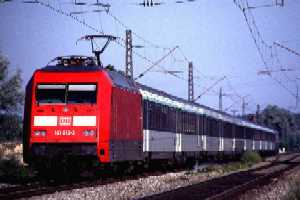 101 012-3 "Verkehrsrot" (by Yutaka Okamoto) |
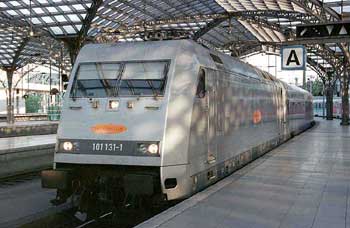 101 131-1 "Metropolitan" (by Matsuura Hiromasa) |
| From the 1970s, high speed passenger trains were hauled mainly by famous
class 103 which could run at 200 kph. In the 1980s, a new electric locomotive
- class 120, was developed and many tests were done. Class 120 aimed to
be used for multi-purpose - from fast passenger trains to heavy freight
trains. But the performance of class 120 isn't enough for these purpose,
and only 60 locomotives were mass-produced. In 1991 ICE service started,
but there are still many passenger trains hauled by a locomotive since
the increase of trains after the unification of West and East Germany.
InterCity and InterRegio were still hauled mainly by class 103, but class
103 became in poor condition, and a development of a new electric locomotive
for fast passenger trains was done. At first class 121 - developed version
of class 120 - was planed, but it was canceled, and the production of a
new locomotives was put off after the start of DBAG. In 1994, Bundesbahn and Reichsbahn aggregated, and a new private company - Deutsche Bahn AG started. In December 1994, DBAG and Adtranz made an temporary agreement on the producrion of new electric locomotives, and on 28 July 1995, 145 locomotives were ordered formally. The class of this new locomotive was 101, and one of class 101 costed 5,600,000DM. The manufacture of class 101 started in December, and in January 1996 the assembling started at ADtranz Kassel factory. On 1 July 1996, the first locomotive was completed and used for test run. On 18 February 1997 EBA alloewed the operation of class 101, and class 101 entered the service from the next day. At first 101 002 and 003 were used for service, and 101 001 continued to be used for tests. The mass-producton of class 101 was continued. The 100th loco was completed in July 1998, and the last 145th loco was completed in June 1999. Class 101 was designed by BPR Design in Stuttgart. There were some plans for the livery of class 101. The most popular plan was the design study by ABB Henschel. According to this study, the side of the loco was painted in silver with red stripes, and the fronts was painted in red and silver. Because under this livery it is difficult to catch sight of when running fast, this plan was rejected. The adopted livery was red / gray livery with white line in the fronts. First three locomotives (101 001 / 002 / 003) were painted in Orientrot (RAL3031) and gray (RAL7039), and the rest loco (101 004 145) were painted in fresher Verkehrsrot (RAL3020) and different gray (RAL7012). It's difficult to distinguish between these liveries. 101 145 has a special livery 101 001 (StarlightExpress livery) and 101 145 were depicted in white on the either side. (At first only 101 001 was depicted.) 101 130 / 131 were assigned to "Metropolitan" and these are painted in Metropolitan livery - silver with MET logos instead of DBAG logos. As SBB Re460 which were also produced by Adtranz, some locomotives of class 101 have advertisement liveries. At first 101 001 was painted in advertisement livery for a railway-related musical "StarlightExpress ". Under the livery, two characters of this musical were painted on the dark violet base of either side. The logo of Maerklin was adhibited on either front. In automn 1999, 101 001 was repainted in a new advertisement livery. The sponsor is DFB (German Football association), since Germany is a candidate for the host country for the World Cup 2006. In May 2000, 18 locomotives were painted in two kinds of advertisement liveries for German major drug maker, Bayer. 11 locomotives were pained in "Bayer" advertisement livery, and 7 locomotives were painted in "Aspirin" (a product of Bayer) livery. In July and August 2000, 4 locomotives were painted in Bayer's new advertisement livery - "Makrolon" (a product of Bayer) livery. In June 2000, some locomotives became a advertisement locomotives of Baden-Württemberg state. In these locomotives, the comments "Nett hier. Aber waren Sie schon mal in Baden-Wuerttemberg?" ("Nice here. But have you been to Baden-Wuerttemberg?") was written on either side. In Septenmber, 101 014 was repainted in a new special blue livery which cereblates 50 year of "Technisches Hilfswerk". From September, other three kinds of advertisement liveries appeared. The sponsor of these advertisement is CMA. Until now, 80 locomotives became CMA loco. 48 locomotives are painted in yellow and have a comment "Mehr Zeit für Kinder (More time for children)". 21 locomotives are painted in sky blue and have a comment "Geniessen auf gut deutsch: mit Fleisch aus unseren Regionen (Enjoying on good Germany: with meat from our regions)". 11 locomotives also have sky blue livery with a comment "Milch. Alles andere schmeckt nur nass (Milk. Everything else tastes only wet)". On the end of January 2001, a new advertising livery of Zetti appeared. 101 138 has this blue livery with "Zetti goes West". |
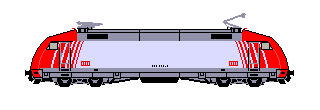 Design Study by ABB Henschel |
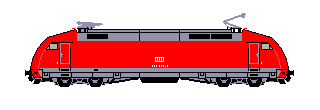 Verkehrsrot |
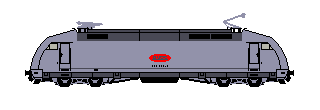 "Metroporitan" |
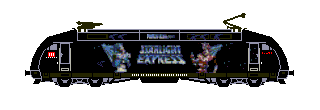 101 001 "StarlightExpress" |
| As classes 145 and 152, class 101 followed "Eco2000" which
aimed to be more efficient and friendly to the environment. Many improvements
were done for the design and machinery of these locomotives from older.
The prototype of class 101 was not built, but the new technology were tested
by class 120 and ABB test locomotive class 128 "12X". Class 101
carries three-phase asnchronous motor, one-wheel-drive system (type : MICAS-S),
and a power supply system named "Integrierter Gesamtantrieb".
It carries not only an electric brake but also a disk brake (type : KE-GPR-EmZ)
to stop safe when running fast. Class 101 has self-diagnosis system, and
it reduces time and labor for maintenance in factories. By these improvements,
class 101 has lighter weight, higher performance and is much more efficient
than old famous class 103. Class 101 adapts to two safety systems, LZB80
and the latest CIR-Elke. CIR-Elke is used between Offenburg and Basel,
and class 101 can run this section. All locomotives of class 145 belong to DB Reise&Touristik and are allocated at Bw Hamburg Eidelstadt. They are operated in electrified lines in whole Germany, and they enter high-speed lines for ICE since they are windtight. They haul mainly InterCity, EuroCity, InterRegio which run at the top speed of 200 kph. Recently a driving cab wagon (EC/IC : Bpmbdzf 297, IR : Bimdzf269.0 / Bimdzf269.2) is coupled in these trains in opposite of the locomotive. This reduced the stop time at some terminal station such as Stuttgart Hbf, Frankfurt Hbf, Hamburg Hbf, München Hbf, and as a result it reduces travel time, increases stop stations, and permits more efficient operation of locomotives. Class 101 can connect to Austria and go to Wien Hbf hauling EuroCity. In Austria, the maxium speed is 160 kph. Class 101 also haules night trains like CityNightLine, NachtZug (ex. InterCityNight), D-zug, local trains and even freight trains. From August 1999, the service of a new express train "Metropolitan" started between Hamburg Hbf and Köln Hbf, and 101 130 / 131 were assigned to this train. When these locomotives are examined, 101 124 / 126 will be used instead of them. "Metropolitan" wagons are the only wagons that can run at 220 kph, but the line between Hamburg Hbf and Köln Hbf is not upgraded, and "Metropolitan" doesn't run even at 200 kph. Now class 101 has no chance running at the maxium speed of 220 kph. Until now class 101 was operated well, but it met some accidents. The most serious accident happen on 6 Februar 2000 at Brühl station near Köln. A D-zug hauled by 101 092 entered a point with limeted speed of 30 kph at 120 kph, derailed and run into a private house. Nine people were killed by the accident. It is said that the accident is responsible for the driver's error. 101 092 was seriously damaged and it is still out of operation. In November 2000, a problem was found out with traction motor bearings for several engines. Now DB exchanges the transformers of all engines. Some opearion are replaced by old class 103. Recently ICE play a main role in German long-distance passenger transportation, but there are still many locomotive-hauling trains, and class 101 will be continue to take an active part. |
![]()
| Class | 101 |
| Number | 145 |
| Built Year | 1996-1999 |
| Length (between buffers) | 19,100mm |
| Width | 2,950mm |
| Weight | 84t |
| Wheel Arrangement | Bo'Bo' |
| Weight per Axlel | 21t |
| Length between Axles | 2,650mm |
| Wheel Diameter | 1,250mm |
| Maxium Speed | 220km/h |
| Power Output | 6,400kW |
| Tranction Power (at start) | 300kN |
| Traction Power (at max. speed) | 104kN |
| Pantograph | DSA350 SEK |
| Power Source | AC15kV, 16 2/3Hz |
![]()
| "Baureihe 101" by Karl Gerhard Baur, GeraMond in 1999 |
| BAHN EXTRA "Bahn-Jahrbuch '99" by GeraNova |
![]()
| Pictures of BR101 |
| Loco List of BR101 |
![]()